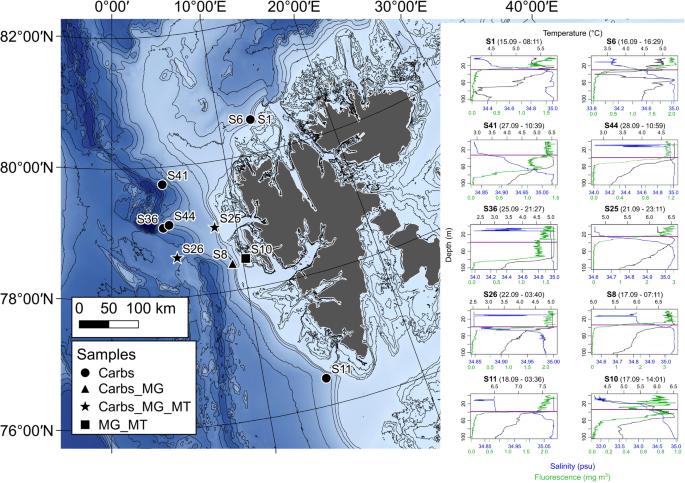Carbohydrates and carbohydrate degradation gene abundance and transcription in Atlantic waters of the Arctic
IF 5.1
Q1 ECOLOGY
引用次数: 0
Abstract
Carbohydrates are chemically and structurally diverse, represent a substantial fraction of marine organic matter and are key substrates for heterotrophic microbes. Studies on carbohydrate utilisation by marine microbes have been centred on phytoplankton blooms in temperate regions, while far less is known from high-latitude waters and during later seasonal stages. Here, we combine glycan microarrays and analytical chromatography with metagenomics and metatranscriptomics to show the spatial heterogeneity in glycan distribution and potential carbohydrate utilisation by microbes in Atlantic waters of the Arctic. The composition and abundance of monomers and glycan structures in POM varied with location and depth. Complex fucose-containing sulfated polysaccharides, known to accumulate in the ocean, were consistently detected, while the more labile β-1,3-glucan exhibited a patchy distribution. Through ‘omics analysis, we identify variations in the abundance and transcription of carbohydrate degradation-related genes across samples at the community and population level. The populations contributing the most to transcription were taxonomically related to those known as primary responders and key carbohydrate degraders in temperate ecosystems, such as NS4 Marine Group and Formosa. The unique transcription profiles for these populations suggest distinct substrate utilisation potentials, with predicted glycan targets corresponding to those structurally identified in POM from the same sampling sites. By combining cutting-edge technologies and protocols, we provide insights into the carbohydrate component of the carbon cycle in the Arctic during late summer and present a high-quality dataset that will be of great value for future comparative analyses.

北极大西洋水域碳水化合物和碳水化合物降解基因的丰度与转录
碳水化合物在化学和结构上多种多样,在海洋有机物中占很大比例,是异养微生物的关键底物。对海洋微生物利用碳水化合物的研究主要集中在温带地区的浮游植物藻华,而对高纬度水域和后期季节阶段的研究则少得多。在这里,我们将糖微阵列和分析色谱法与元基因组学和元转录组学相结合,展示了糖分布的空间异质性以及微生物在北极大西洋水域利用碳水化合物的潜力。POM 中单体和聚糖结构的组成和丰度随地点和深度而变化。我们持续检测到了复杂的含岩藻糖的硫酸化多糖(已知会在海洋中积累),而更易溶解的β-1,3-葡聚糖则呈现出零星分布。通过'omics'分析,我们确定了不同样本中碳水化合物降解相关基因在群落和种群水平上的丰度和转录变化。对转录贡献最大的种群在分类学上与温带生态系统中已知的主要响应者和关键碳水化合物降解者有关,如 NS4 海洋组和福尔摩沙。这些种群独特的转录特征表明它们具有不同的底物利用潜力,预测的糖目标与在相同采样点的 POM 中发现的结构相对应。通过结合尖端技术和方案,我们深入了解了夏末北极地区碳循环中的碳水化合物成分,并提供了一个高质量的数据集,对未来的比较分析具有重要价值。
本文章由计算机程序翻译,如有差异,请以英文原文为准。
求助全文
约1分钟内获得全文
求助全文

 求助内容:
求助内容: 应助结果提醒方式:
应助结果提醒方式:


